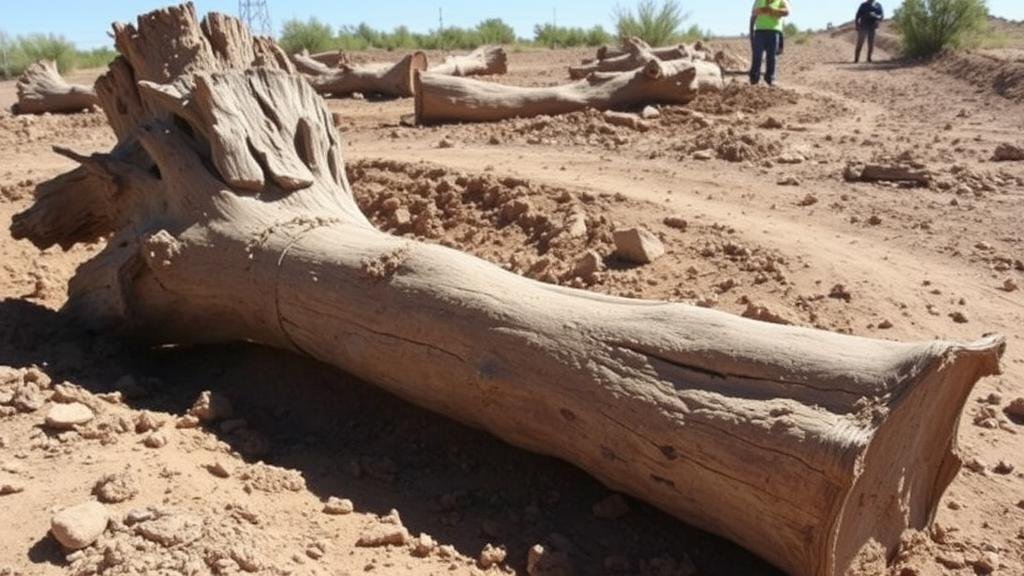Excavating fossilized tree trunks in the ancient floodplain deposits near Silver City.
Excavating Fossilized Tree Trunks Near Silver City
The ancient floodplain deposits near Silver City, renowned for their rich geological history, are a prime location for rockhounds and mineral collectors seeking fossilized tree trunks. These fossils offer a glimpse into the lush environments of prehistoric times and provide valuable insights into the planets climatic changes.
Understanding the Geological Context
The deposits around Silver City were once part of a vibrant ecosystem roughly 15 to 20 million years ago during the Miocene epoch. This area was characterized by extensive riparian zones and alluvial plains, where rivers meandered and deposited rich sediments. As time progressed, the organic materials, including tree trunks, became buried under layers of sediment and subsequently fossilized.
Fossilized wood found in these deposits exhibits remarkable preservation, often retaining cellular structures that allow paleobotanists to study ancient plant life. The process of fossilization typically involves permineralization, where mineral-rich water permeates the cellular structure of the wood, replacing organic material with minerals such as silica, calcite, and pyrite.
The Types of Fossilized Wood
Rockhounds exploring this area can encounter a variety of fossilized wood types, each presenting unique characteristics:
- Petrified Wood: This well-preserved form displays vibrant colors and intricate patterns, making it highly sought-after by collectors.
- Cypress and Pine Fossils: Common in these deposits, these species offer insight into the forest composition during the Miocene.
- Silicified Wood: This variety has undergone extensive mineral replacement, resulting in glass-like transparency, often used in jewelry making.
Scientific Importance of Fossilized Tree Trunks
Studying these fossilized trunks is crucial for understanding the ecological dynamics of ancient environments. For example, the isotopic analysis of carbon within the fossilized wood can provide data about prehistoric climate conditions, including temperature variations and rainfall patterns.
A recent study indicated that certain tree species that thrived during the Miocene had adaptive traits that allowed them to flourish under varying CO2 levels. e insights are invaluable as they help current scientists model climate change scenarios.
Practical Tips for Collectors
For rockhounds and mineral collectors interested in excavating fossilized tree trunks near Silver City, consider the following:
- Research Local Regulations: Ensure adherence to state laws regarding fossil collection to avoid penalties and respect protected areas.
- Use the Right Tools: Equipped with a geological hammer, chisel, and brushes, collectors can effectively excavate and clean fossil specimens.
- Ensure Proper Excavation Techniques: Digging around the fossil gently helps prevent damage; always work in layers to reveal the fossil without breaking it.
- Document Findings: Keep a detailed log of fossil locations and characteristics, which can contribute to local geological records.
Real-World Applications in Collecting
Beyond personal enjoyment, the collection of these fossils can create opportunities for educational outreach. Many enthusiasts share their finds with local schools or museums, showcasing the significance of paleontology and geology to younger generations.
Also, collectors often engage with online communities, sharing images and information about their finds, thus fostering a collaborative atmosphere in the rockhounding community. Participating in local geology clubs can also provide education on proper excavating techniques and further enhance collecting skills.
Conclusion
Excavating fossilized tree trunks in the ancient floodplain deposits near Silver City offers rockhounds an exciting opportunity to connect with history and geology. By understanding the scientific significance, utilizing the right techniques, and engaging with the community, collectors can enhance their knowledge and appreciation of these remarkable natural artifacts.
As you embark on your fossil-hunting adventures, remember that each finding not only enriches your collection but also contributes to the broader understanding of our planets past.



